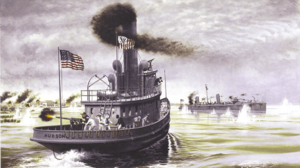Battle of Cárdenas facts for kids
Quick facts for kids Battle of Cárdenas |
|||||||
|---|---|---|---|---|---|---|---|
| Part of the Spanish–American War | |||||||
 USRC Hudson and USRC Winslow, Doug Ellis |
|||||||
|
|||||||
| Belligerents | |||||||
| Commanders and leaders | |||||||
| Strength | |||||||
| 2 gunboats 1 armed tug |
2 torpedo boats 2 gunboats 1 cutter |
||||||
| Casualties and losses | |||||||
| 1 wounded |
5 killed 3 wounded 1 torpedo boat disabled 1 gunboat |
||||||
The Battle of Cárdenas was a small naval fight during the Spanish–American War. It happened on May 11, 1898, in the port of Cárdenas, Cuba. Five American ships, led by Captain Chapman C. Todd, fought against three smaller Spanish ships. The Spanish ships were commanded by Mariano Mateu.
This battle was a rare loss for the Americans. It made the U.S. Navy decide not to attack the port again.
Contents
What Led to the Battle of Cárdenas?
In May 1898, a small group of United States Navy ships was near the northern coast of Cuba. This group included the torpedo boats USS Foote and USS Winslow. It also had the gunboats USS Wilmington and USS Machias. The U.S. Revenue Cutter Hudson was also part of the group.
On May 11, 1898, these ships entered the Bay of Cárdenas. Their goal was to destroy three small Spanish gunboats. These gunboats were reportedly docked in the harbor. After checking the area for mines, Captain Todd gave an order. He told the Winslow to go closer to the shore. It needed to check a steamer docked at the wharf. They wanted to see if it was an enemy warship.
Spanish Ships in Cárdenas
The Spanish ships in Cárdenas were the Ligera, Alerta, and Antonio López. Teniente de Navío Mariano Mateu commanded them. The Ligera was a 42-ton ship. It had chased away the Foote two weeks earlier. Lieutenant Antonio Pérez Rendón commanded it. The Alerta was the same size. Lieutenant Pasquín commanded it. Both gunboats had a 42 mm cannon and a 37 mm Maxim gun.
The Antonio López was a small tug boat. It had a Nordenfelt gun. Lieutenant Domingo Montes Reguefeiros commanded it. The Spanish Line had given this tug to the navy years before.
The Battle Begins
By 1:35 PM, the Winslow was about 1,500 yards from its target. A puff of white smoke from the Antonio López's front gun started the fight. This artillery battle lasted one hour and 20 minutes. The Winslow fired back with its 1-pounder guns.
The Spanish ships focused their fire on the Winslow. Soon, it was hit several times. The first hit destroyed its steering system. The crew tried to set up a backup steering system. But the ship turned sideways to the enemy. Another shot hit its hull near the engine room. This put one of its main engines out of order. The Winslow used its remaining engine to move and avoid enemy fire. It kept firing back with its 1-pounders.
The Wilmington and Hudson also started firing at the Spanish ship and the shore. The combined fire from the three American warships stopped the Spanish tugboat. Several buildings along the waterfront also caught fire.
A Costly Tow
The Winslow was badly damaged. It asked the Hudson to tow it away from the fight. The Hudson came close to the damaged torpedo boat. It set up a tow line between the two ships. As the Hudson began to tow the Winslow out to sea, one of the last Spanish shells hit the torpedo boat. It struck near the starboard gun.
This shot killed Ensign Worth Bagley. He had been helping to guide the ship's movements. Ensign Bagley became known as the first U.S. naval officer killed in the Spanish–American War. Four other sailors also died with him: John Barberes, John Daniels, George B. Meek, and E.B. Tunnell.
What Happened After the Battle?
The Winslow was severely damaged and was towed away. Its commanding officer and several crew members were wounded. Lieutenant John Bernadou made sure the dead and wounded were moved to the Hudson. He then left the ship. He gave command to Chief Gunner's Mate George P. Brady. Brady, along with Chief Gunner's Mate Hans Johnsen and Chief Machinist T. C. Cooney, later received the Medal of Honor.
At that time, members of the Revenue Cutter Service could not get the Navy Medal of Honor. So, Congress approved a special medal for them. Frank Newcomb, the commander of the Hudson, received the medal in gold. His officers got it in silver, and the enlisted crewmen in bronze. On the Spanish side, Teniente de Navío Montes, who commanded the Antonio López, received the Laureate Cross of Saint Ferdinand.
The Spanish gunboat group was made of two steam launches and an armed tug. They were not damaged during the war. All these units were sold by the Spanish government when the war ended.
Ships Involved in the Battle
Spain
Gunboats
- Ligera
- Alerta
Armed tug
- Antonio López
United States
Gunboats
- USS Wilmington
- USS Machias
Torpedo boats
- USS Foote
- USS Winslow
Cutter
- USRC Hudson
See also
 In Spanish: Batalla de Cárdenas para niños
In Spanish: Batalla de Cárdenas para niños


